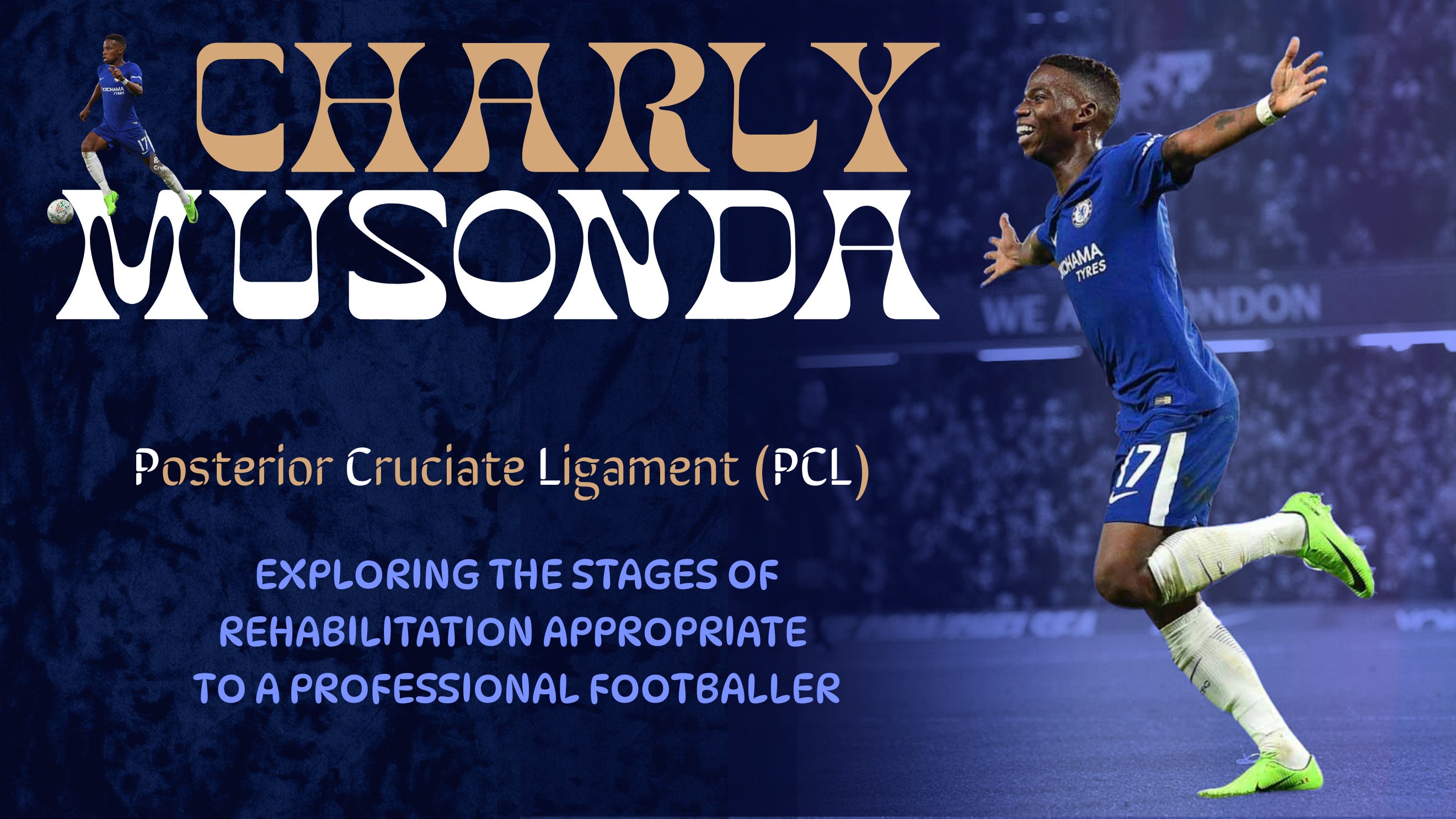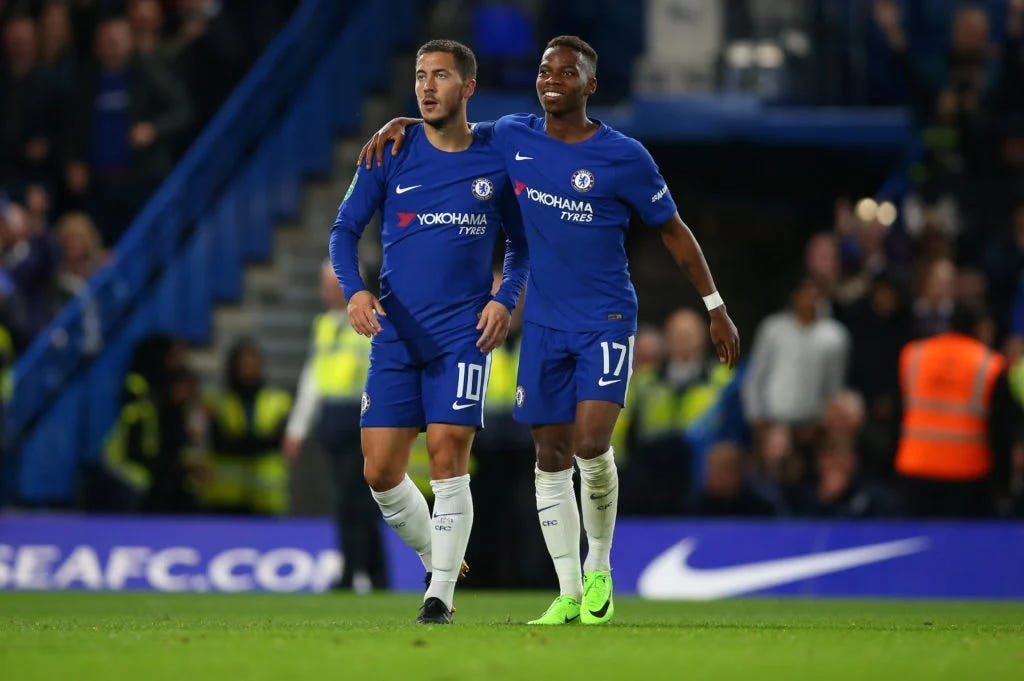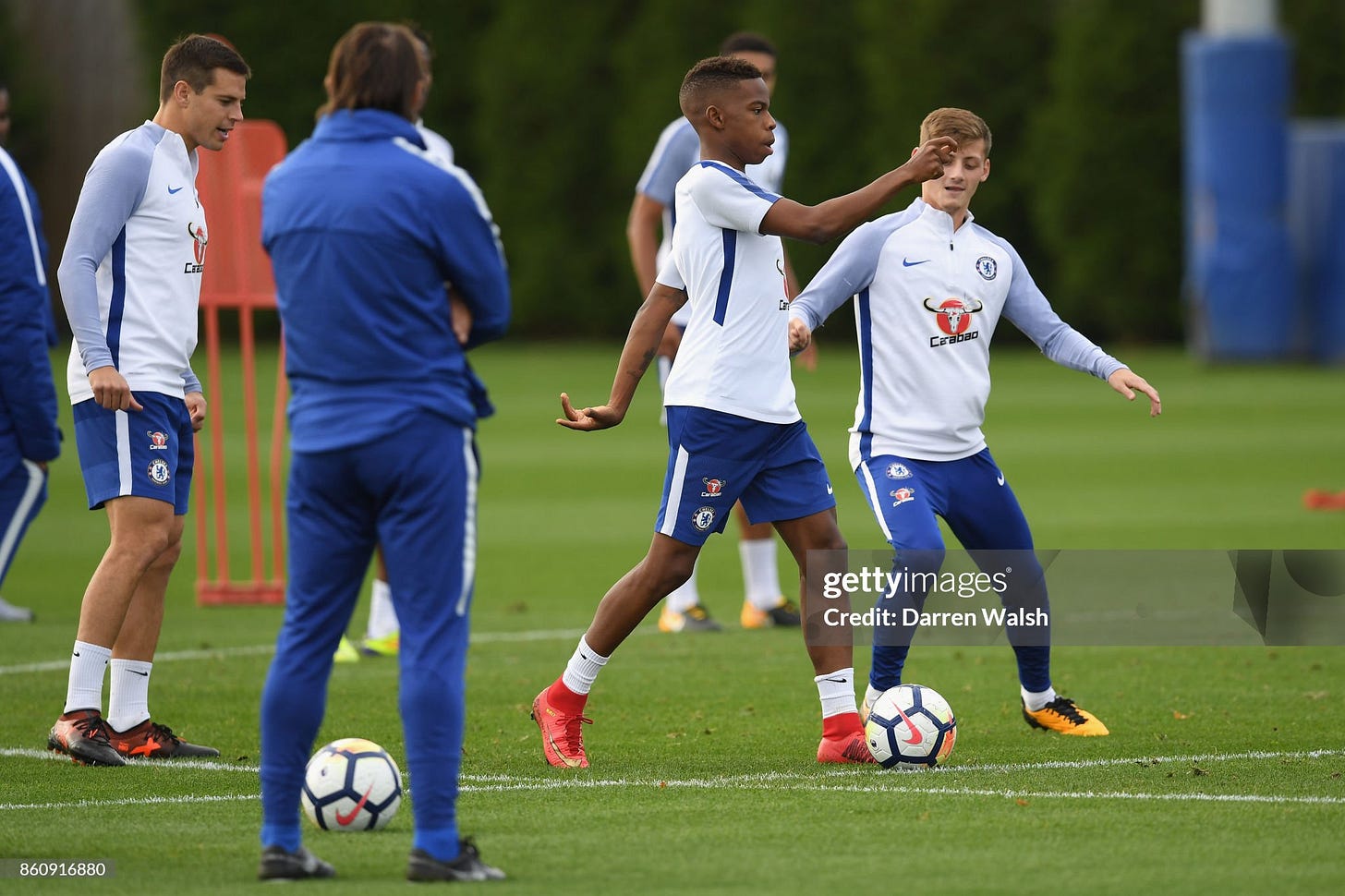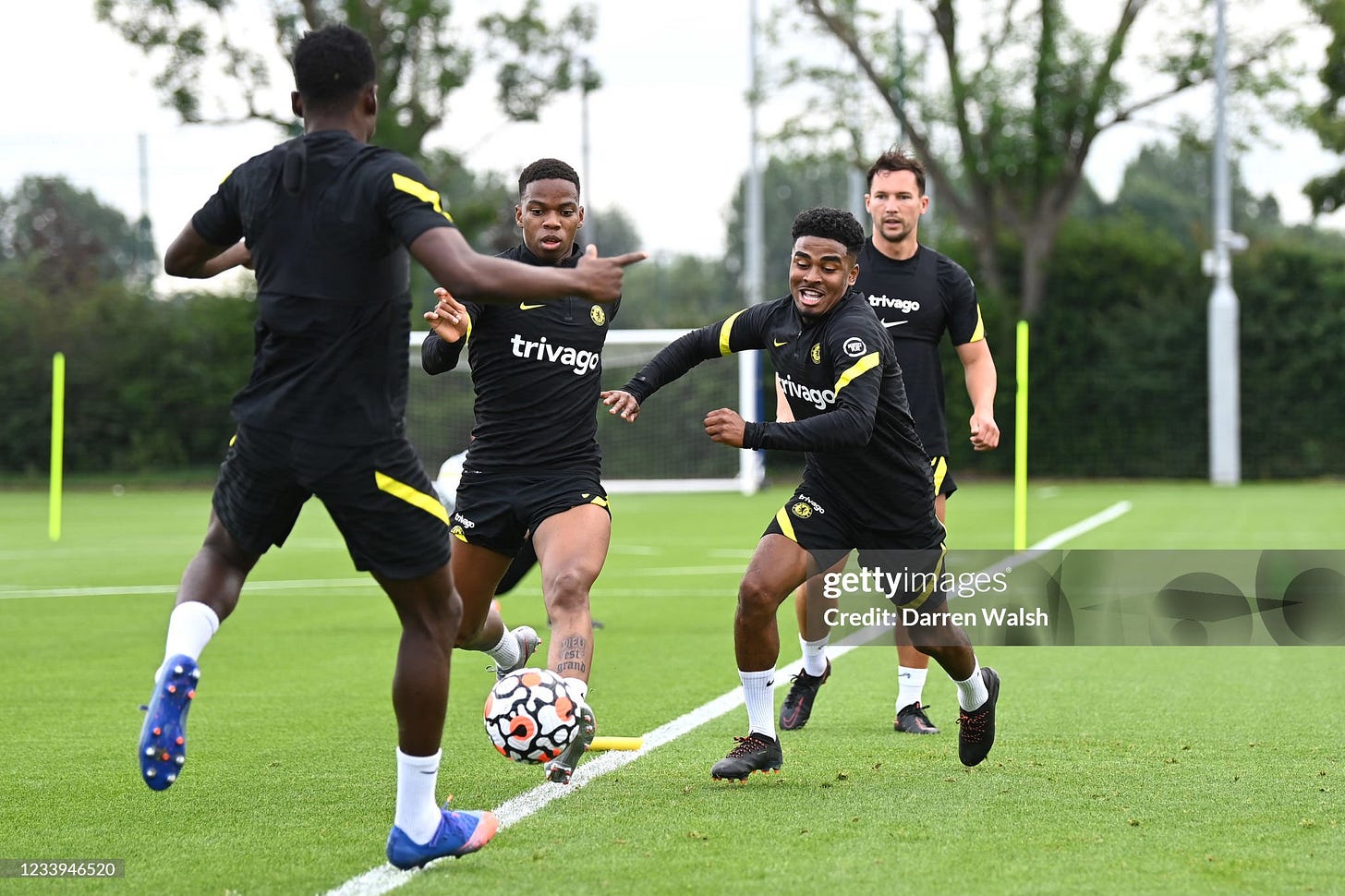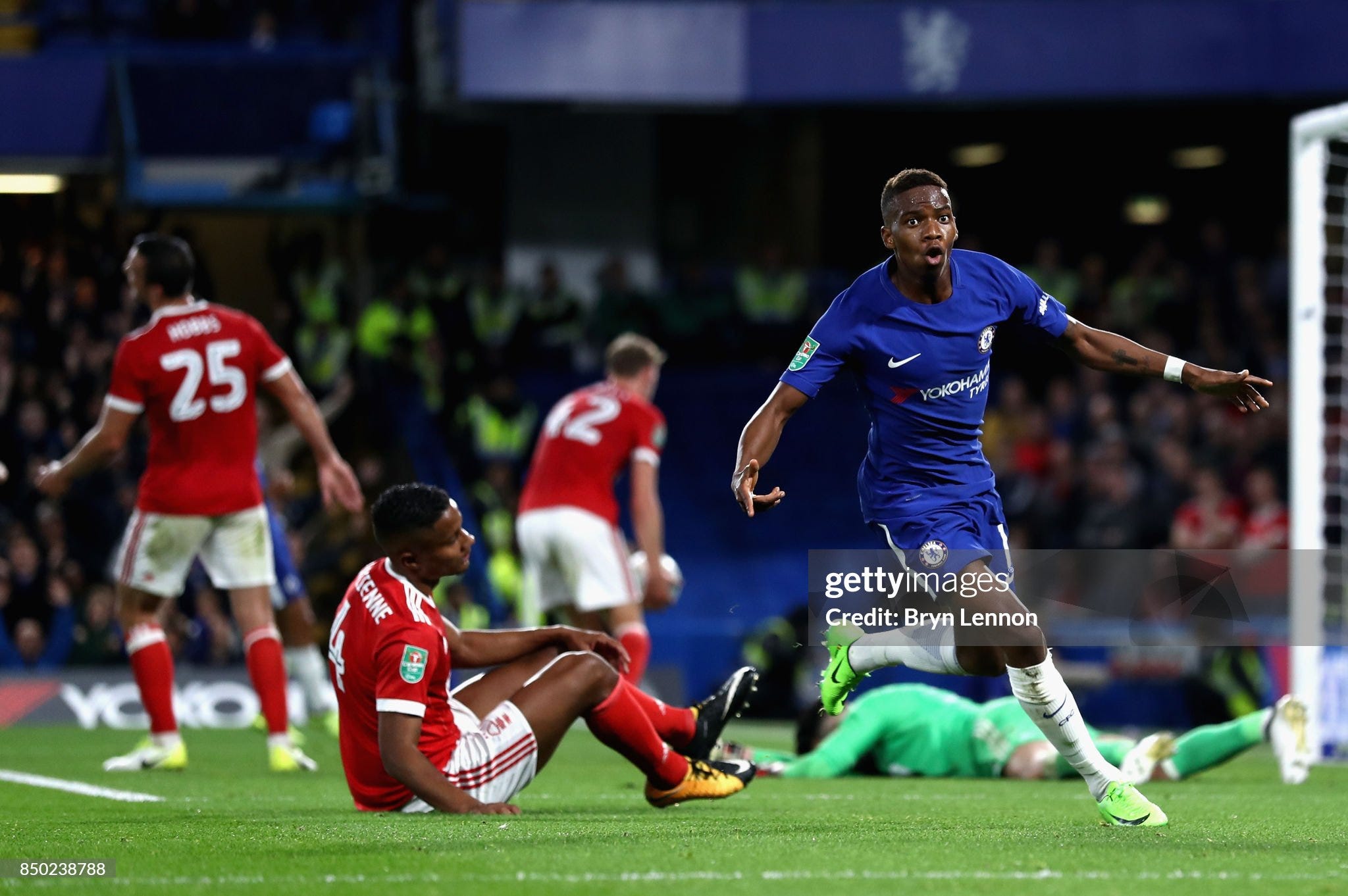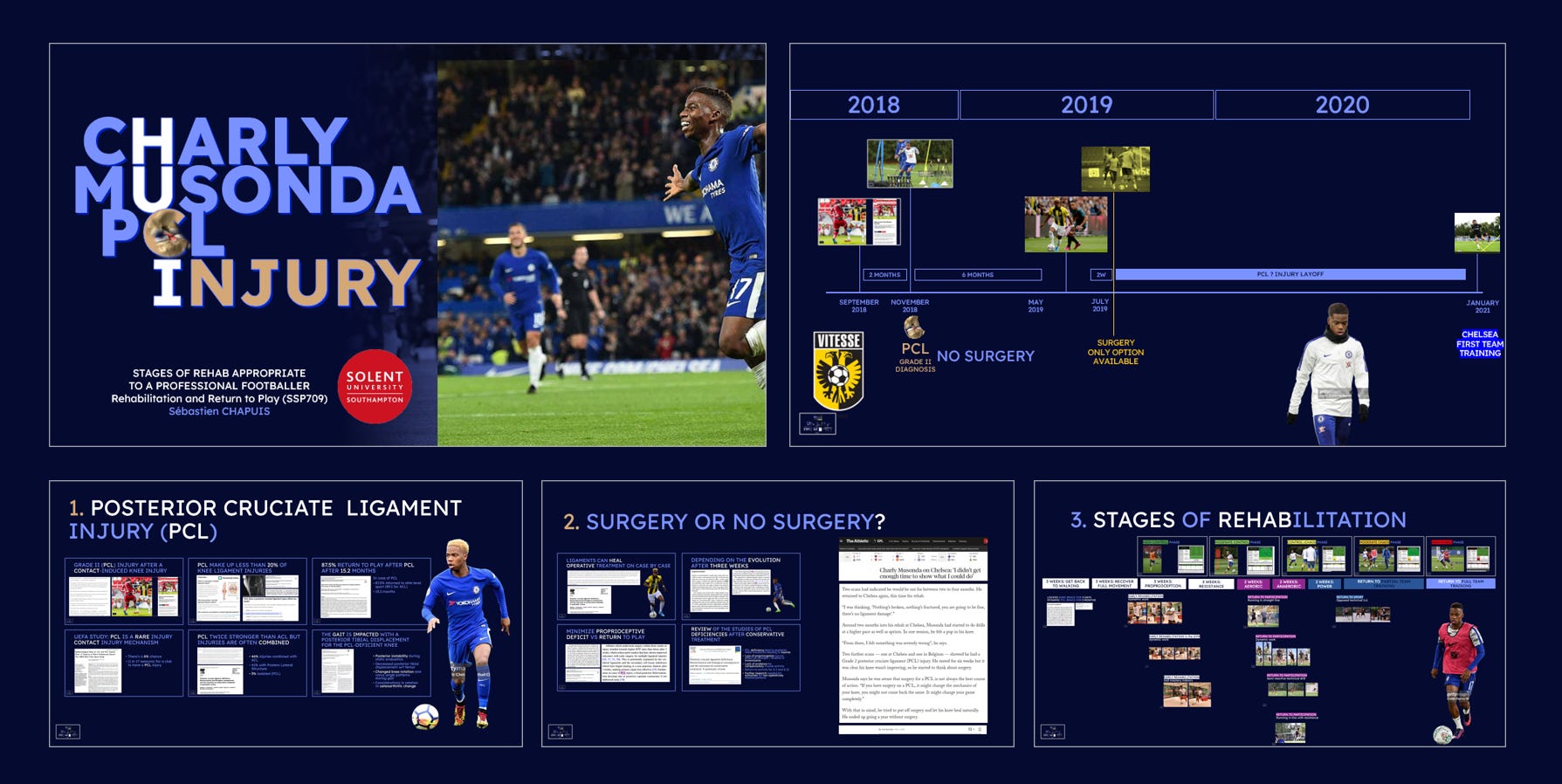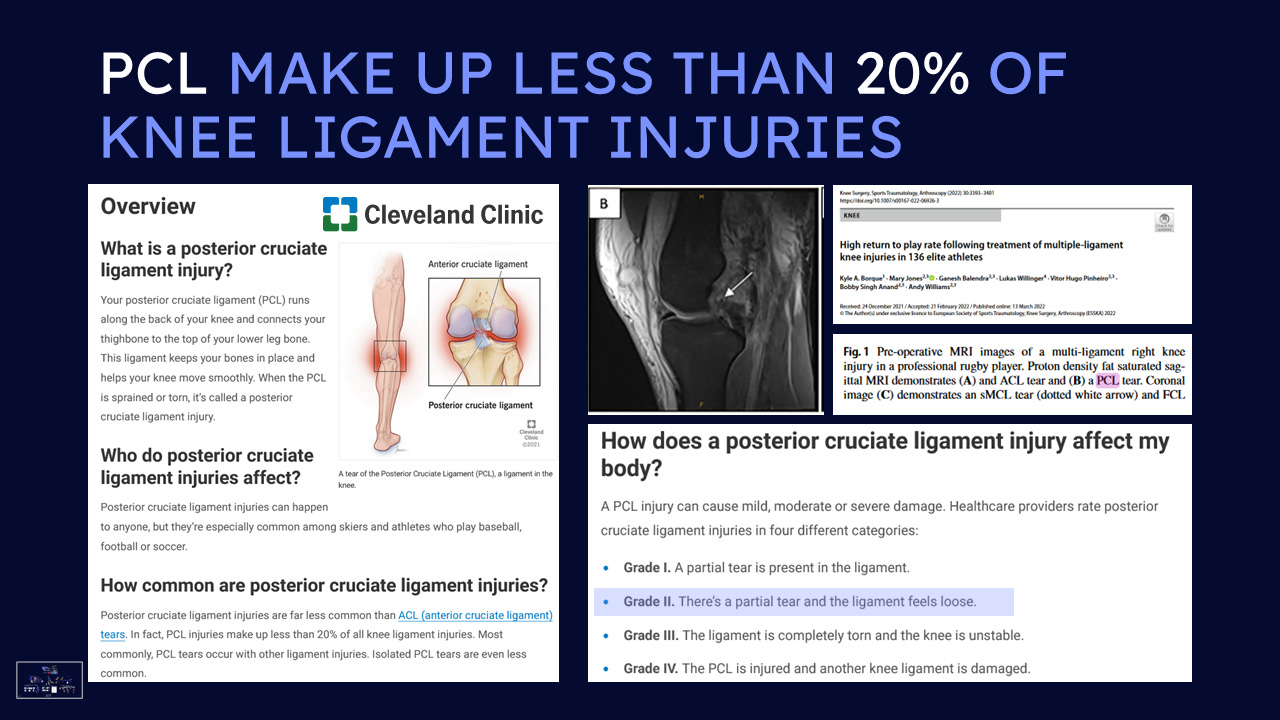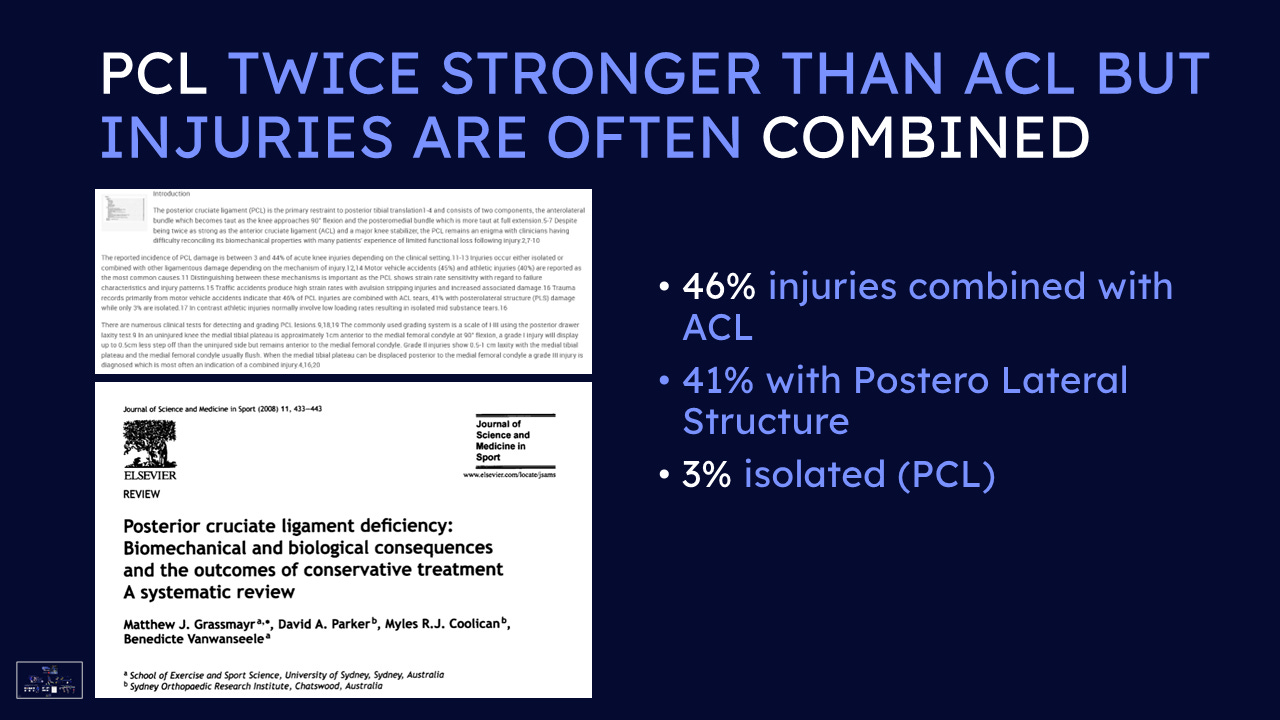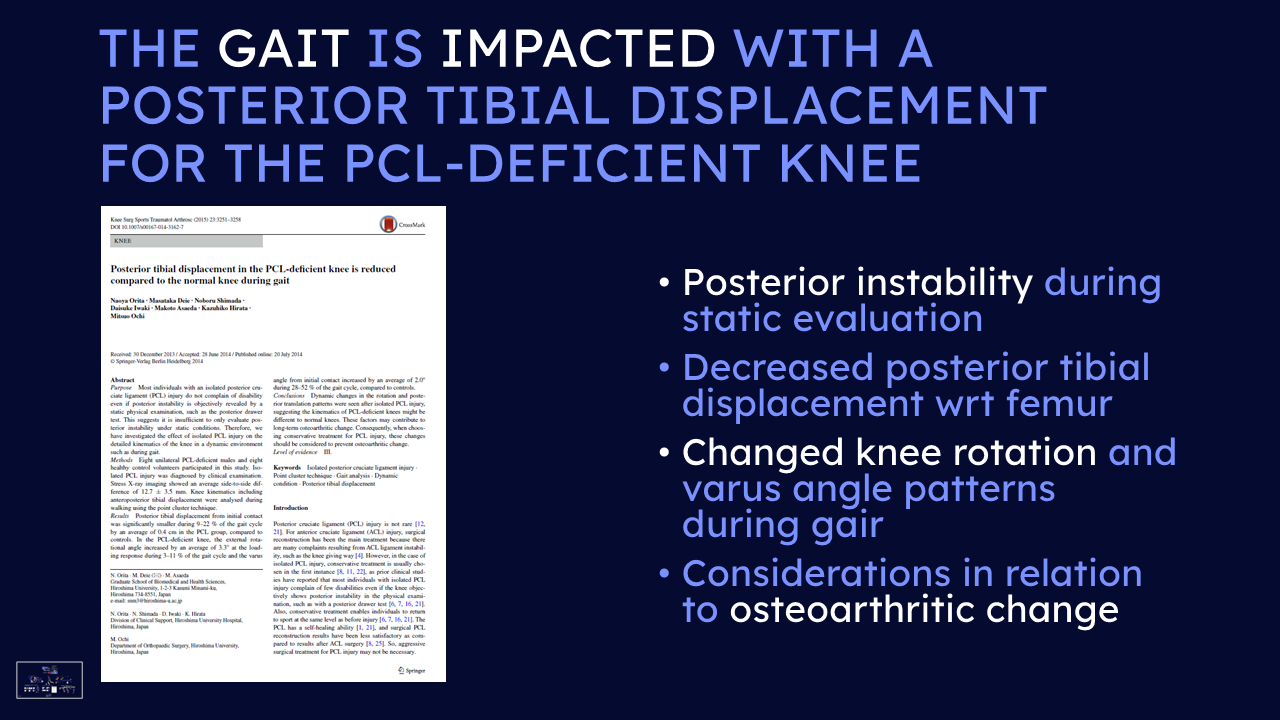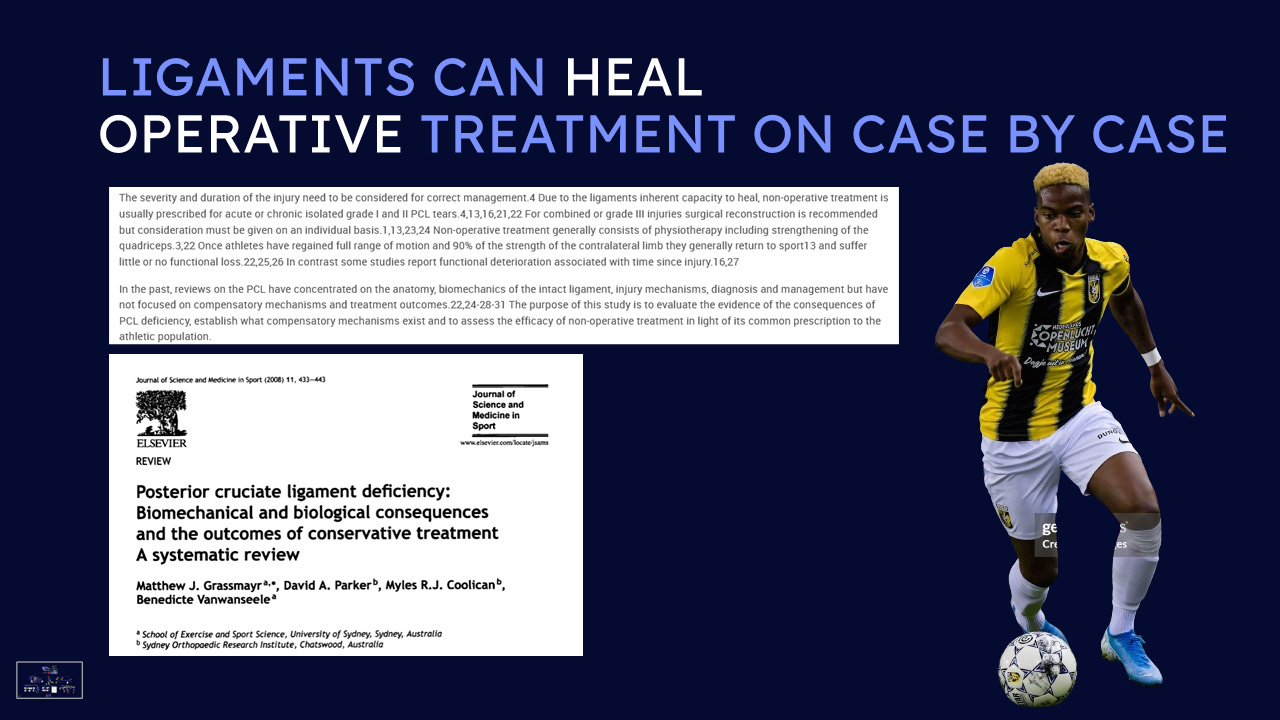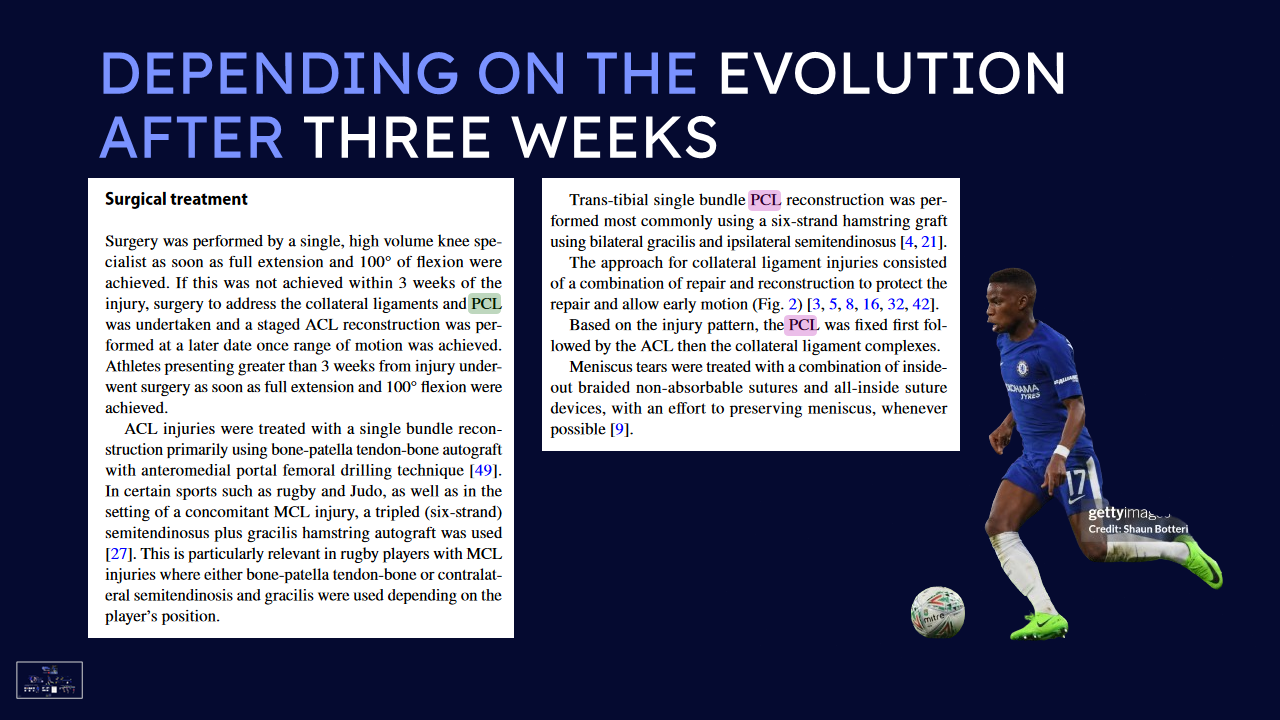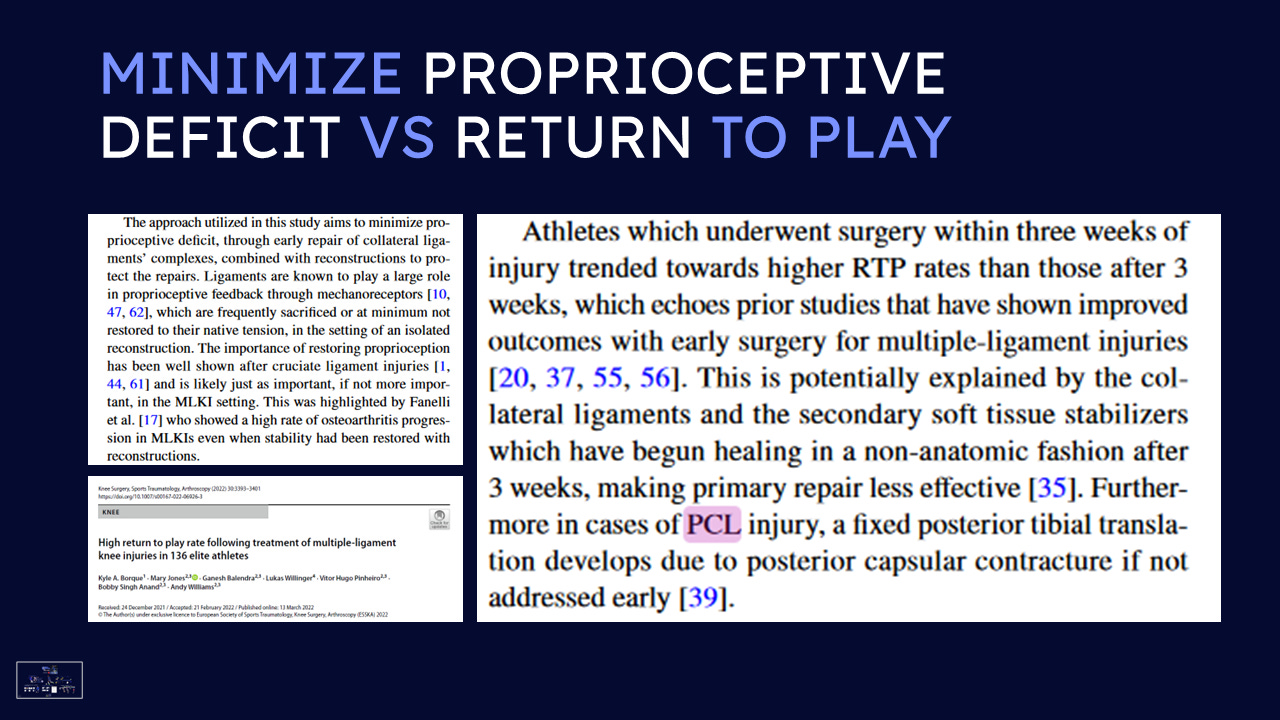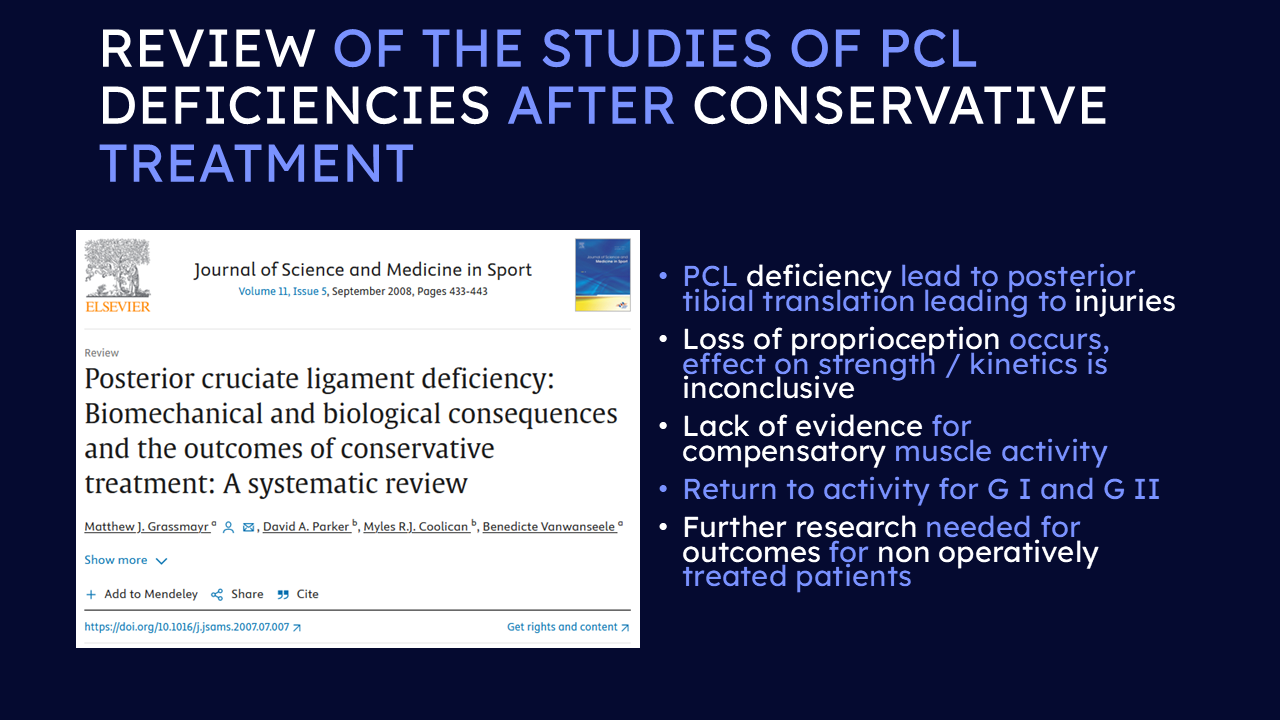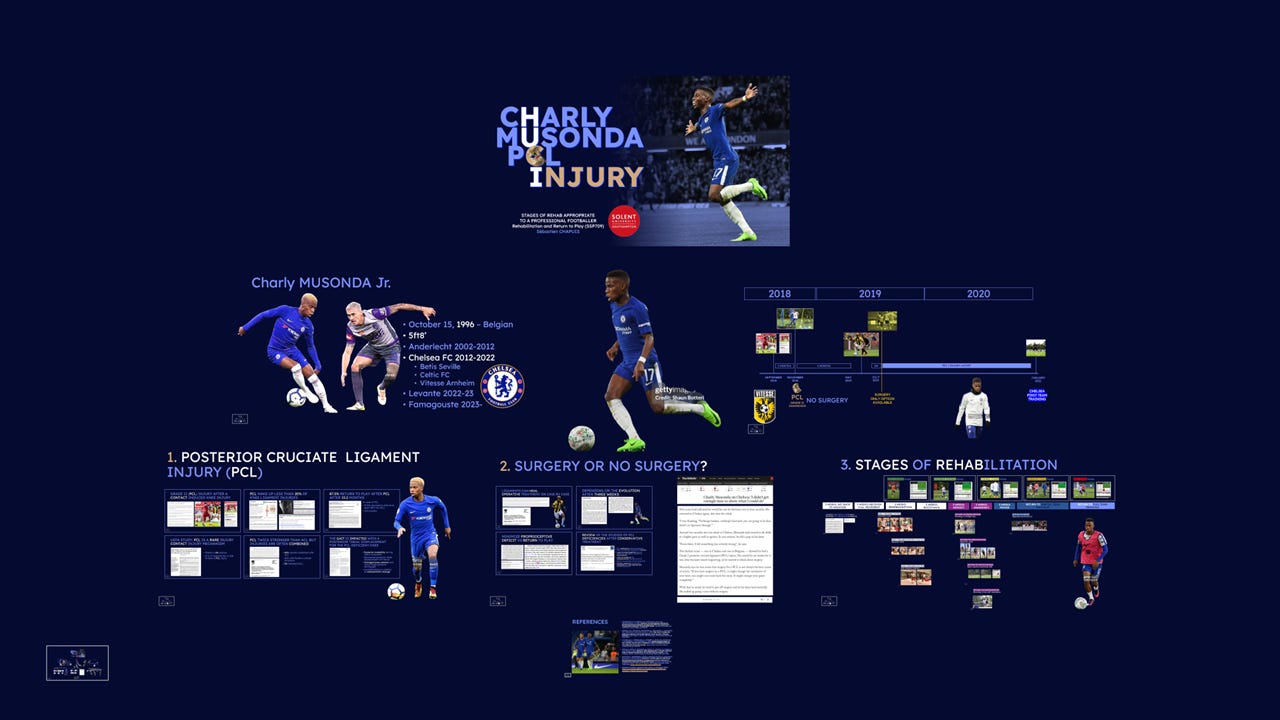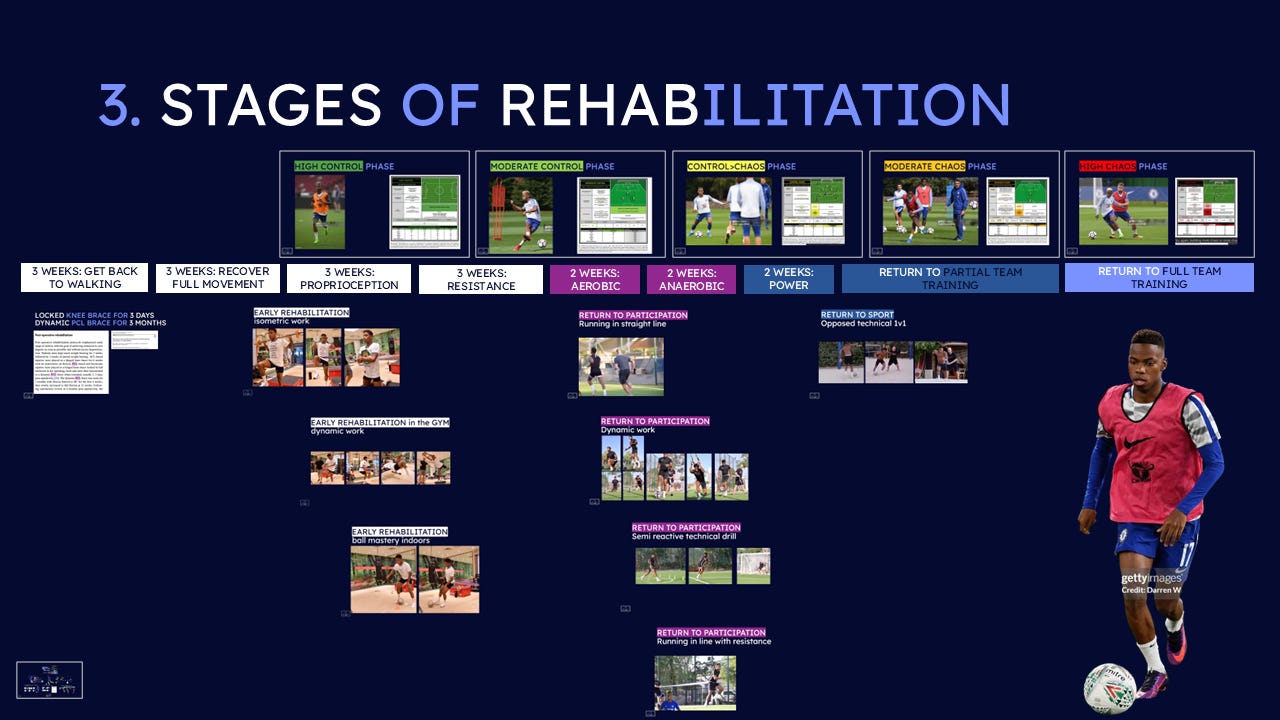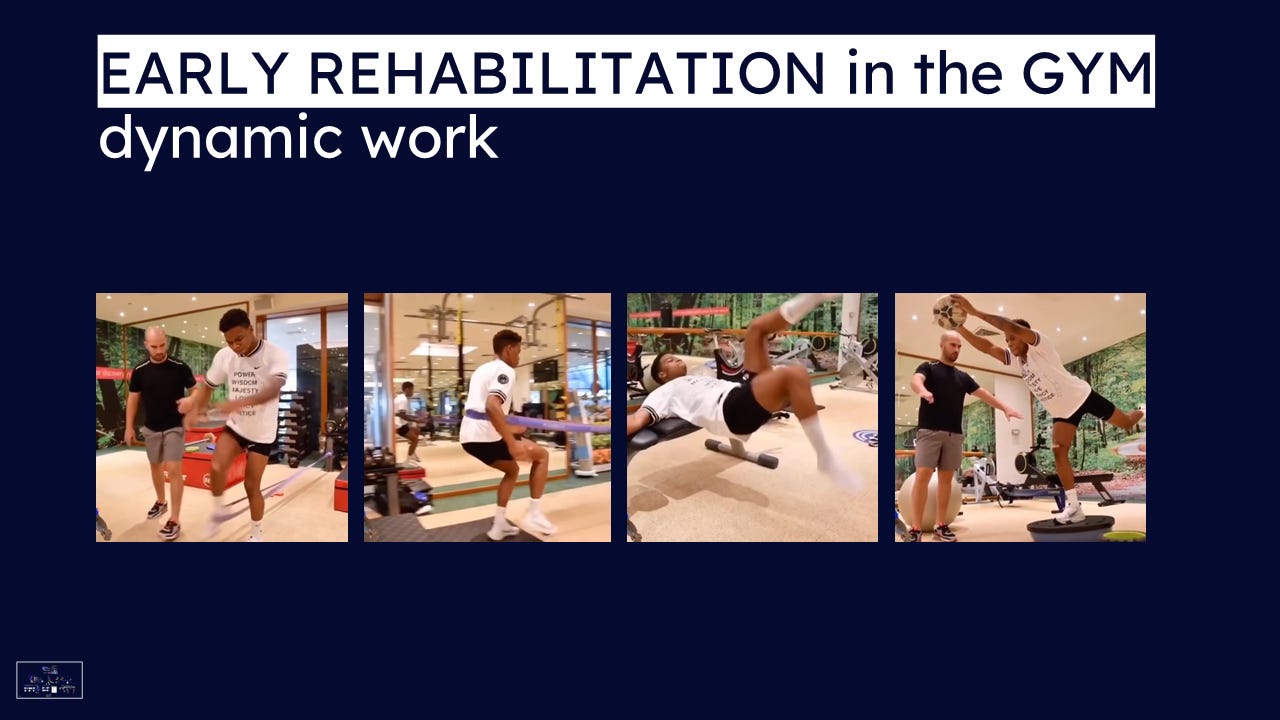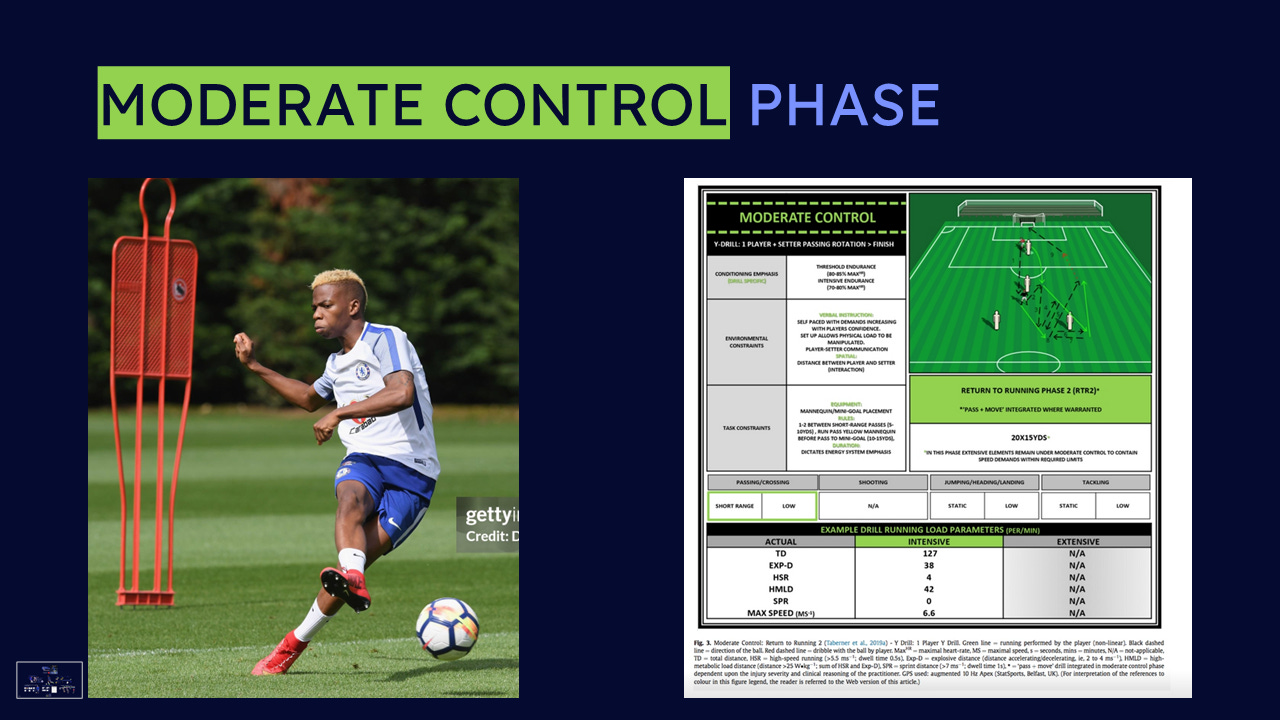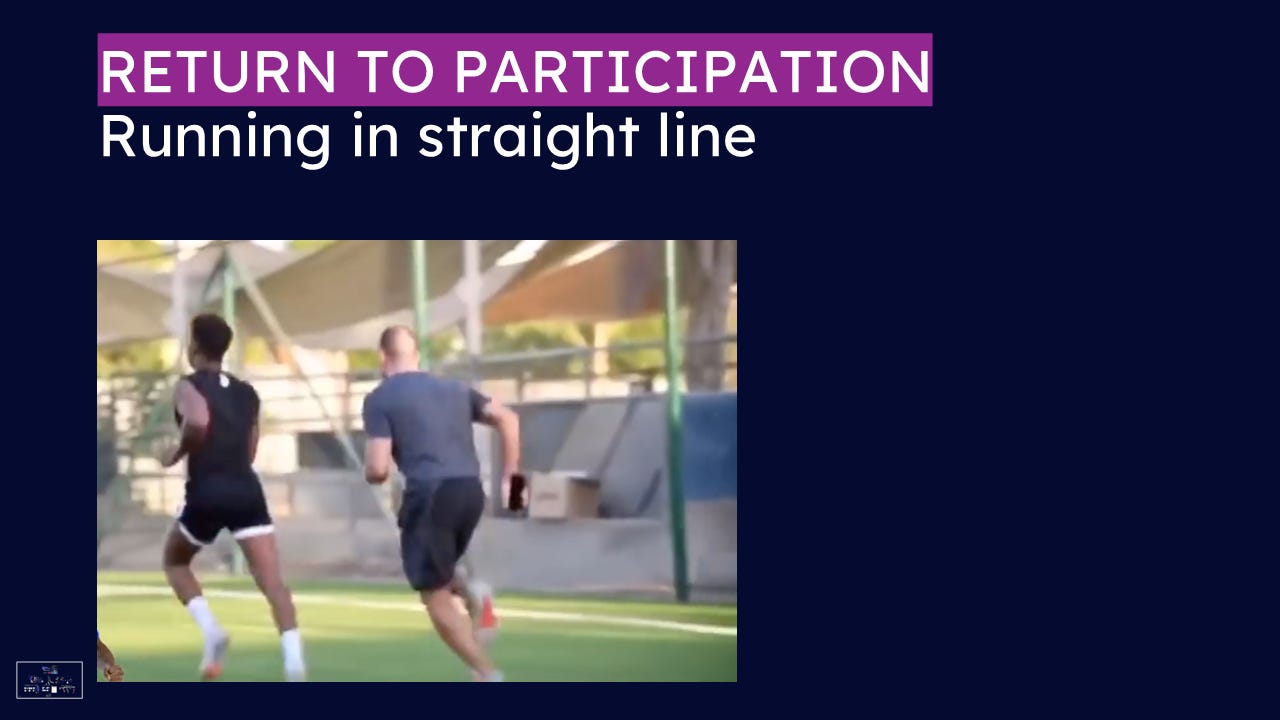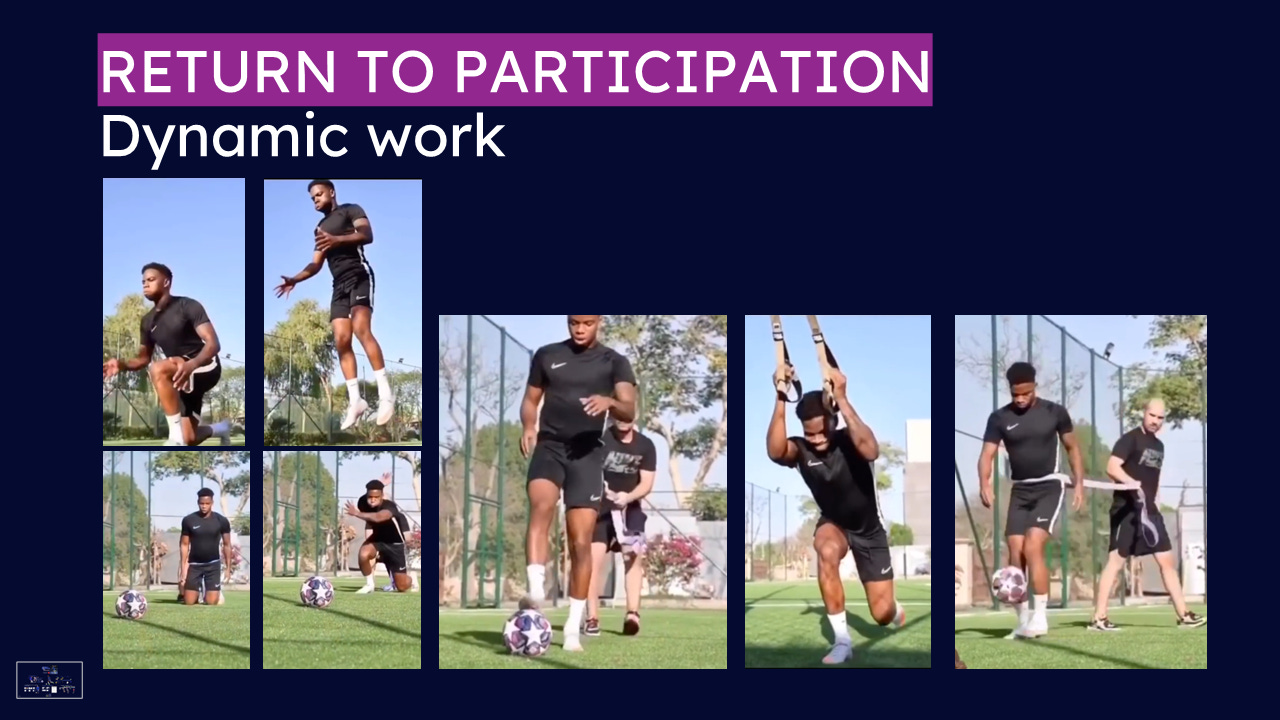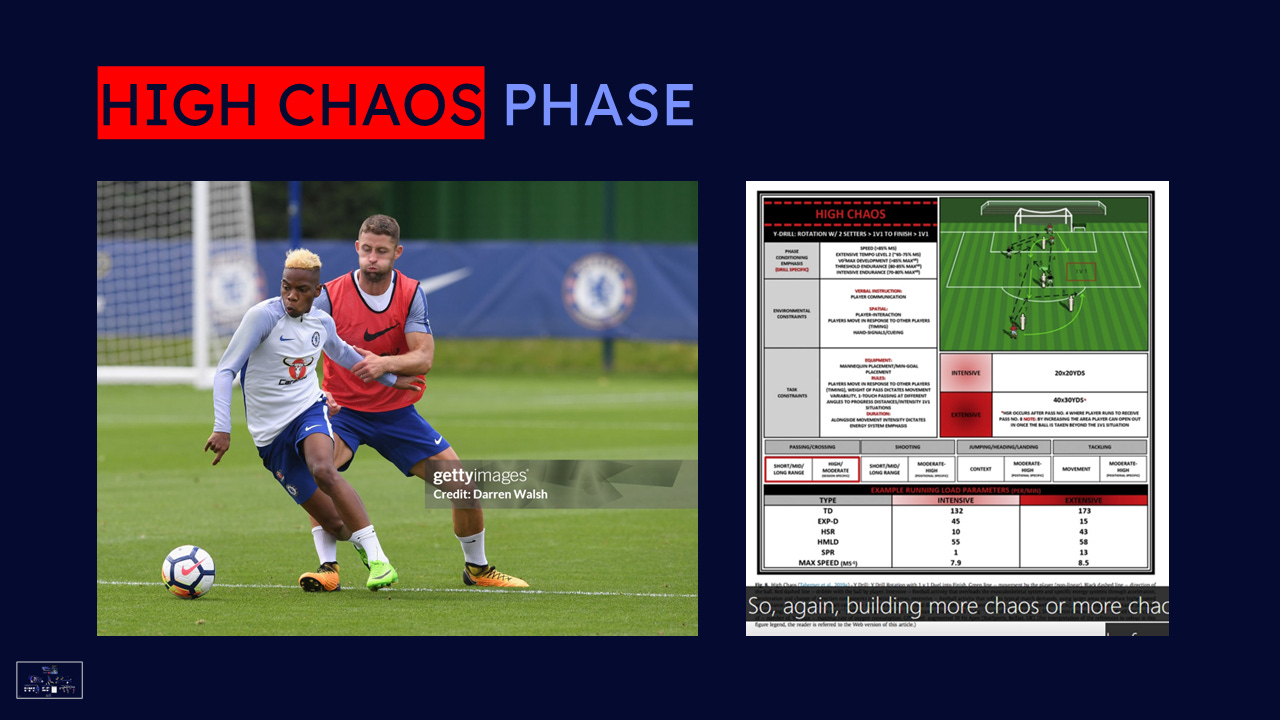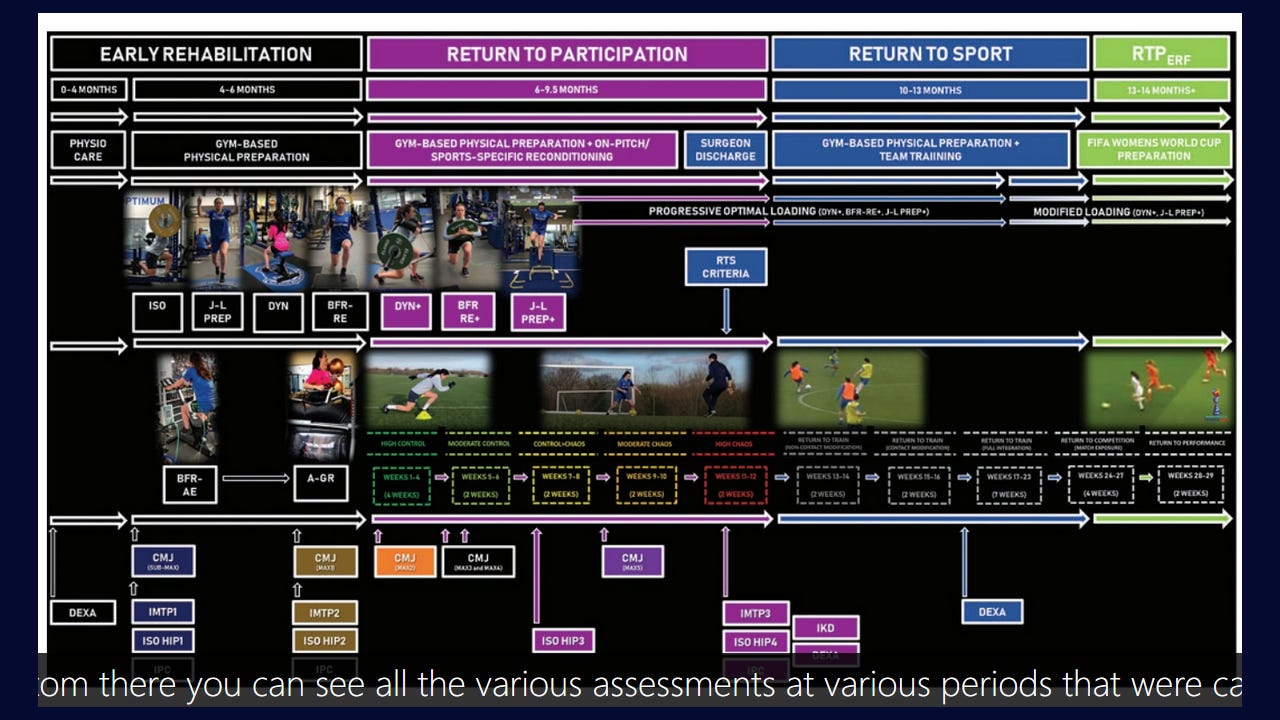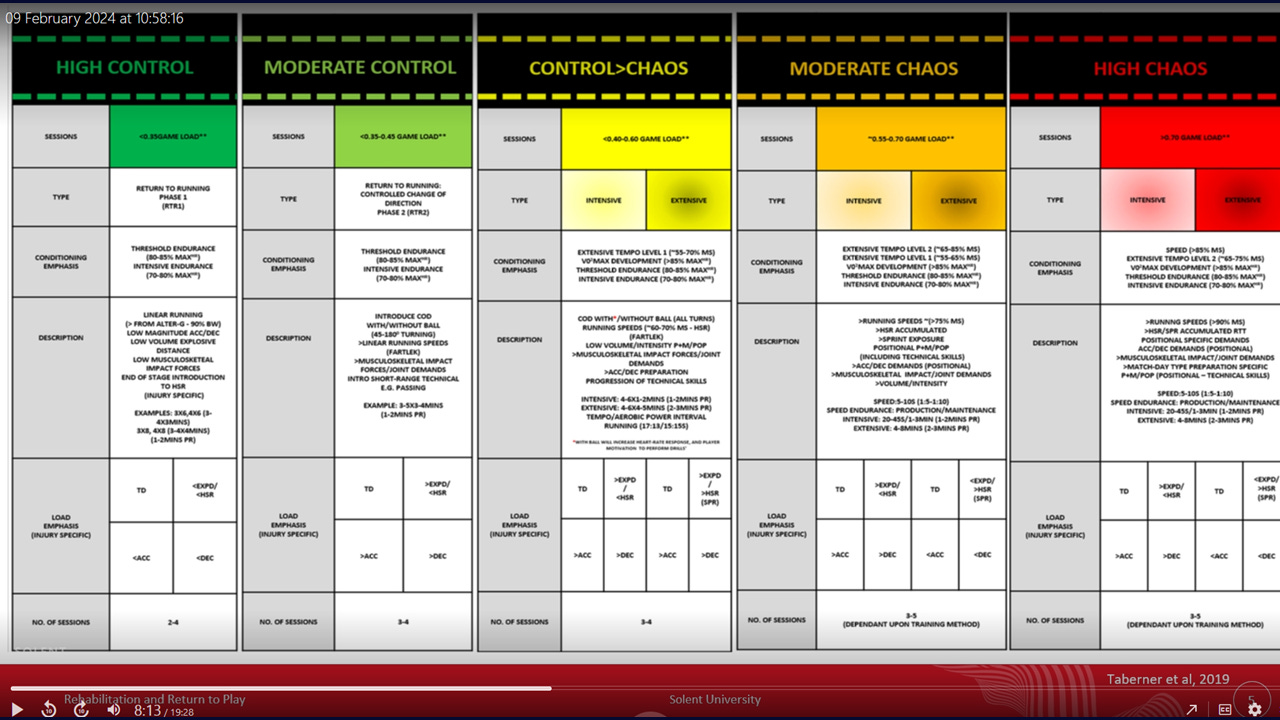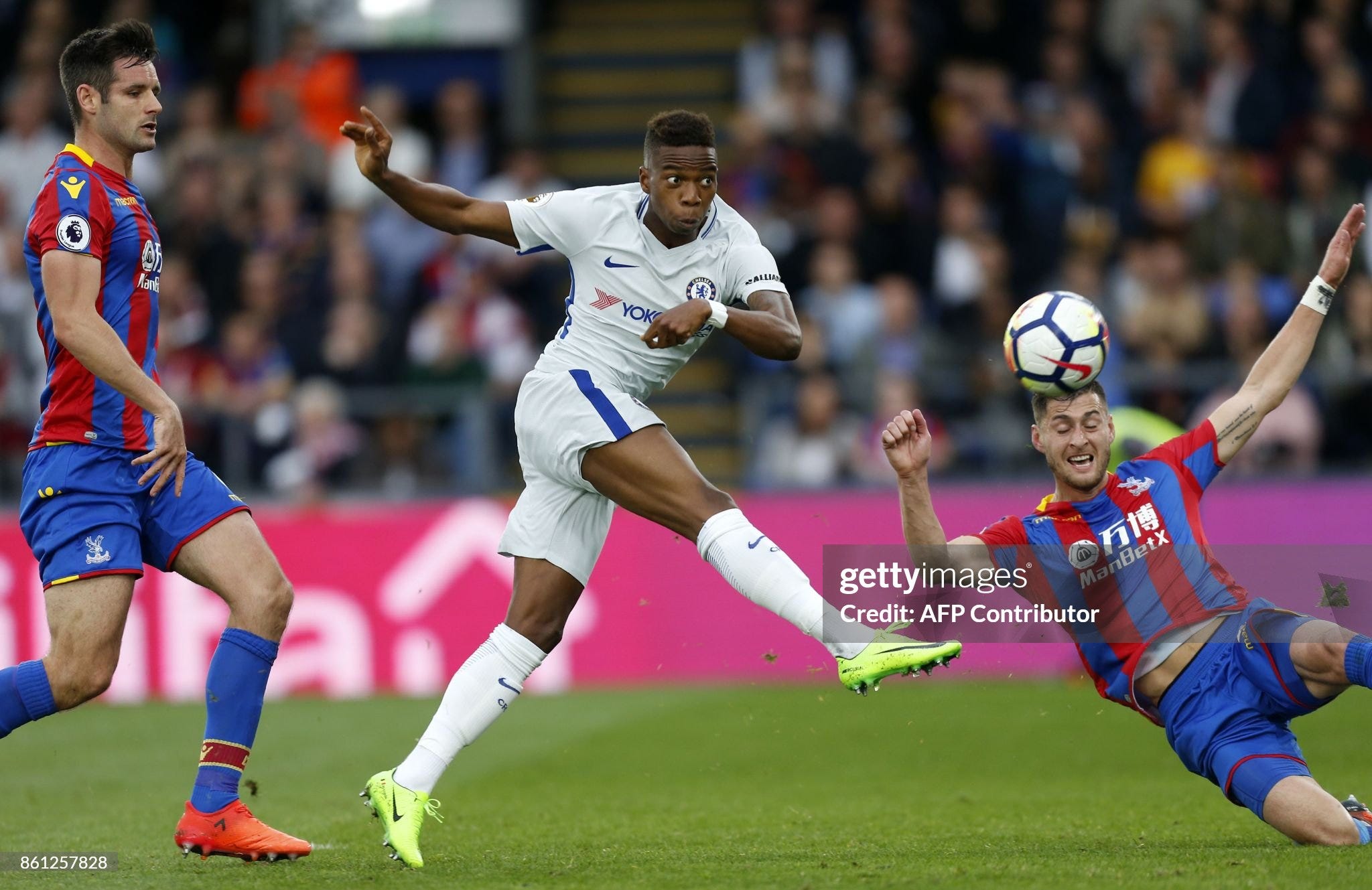A Scar Between Talent and Time
Exploring the stage of rehabilitation appropriate after a Posterior Crucial Ligament (PCL) injury
Adapting a MSc Football Science assignment - that I completed (overall) with 69.5% and a distinction.
This is a practical application based on Taberner and al’s framework from 2019, which is one of the dozen articles anyone with an interest in injury rehabilitation protocols has to have at disposal.
Taberner M, Allen T, Cohen DD
Progressing rehabilitation after injury: consider the ‘control-chaos continuum’
British Journal of Sports Medicine 2019;53:1132-1136.
https://doi.org/10.1136/bjsports-2018-100157
Sadly, Charly Musonda retired this month from professional football.
Football is a fiercely competitive industry, chaotic and sometimes dangerous for players who make a living out of it.
In an era of influencers, and the latest flavour of the month replacing the latest one ; but also the “Troll Football” ecosystem that ends up brainwashing casual football audiences into thinking elite sportsmen happen to be “injury prone” by accident, like that relative who almost knocks the table over twelve pints deep.
Ousmane Dembélé eventually got over the injury-ladden years, mostly due to being overplayed when he couldn’t handle it ; up to the point the tendon had to be re-attached to the bone.
There’s an underworld of sweats, tears and disappointment that can lead sportspeople into a dark place on their way back to recovery. Not everyone is programmed to become a professional footballer, but not every professional footballer is wired to complete a full recovery from injury after setbacks.
Will be explored
The Posterior Cruciate Ligament Injury
Surgery or No Surgery
The Stages to Rehabilitation
The key takeaways are :
Acknowledge the difference between non-contact injuries (muscular) that can be avoided most of the time - and contact injuries that you can’t. And in this case, how a footballer earning 5 digits a week can find himself with a PCL ligament trauma generally only found in frontal car crash. A necessary perspective to challenge the uninformed “can’t cut it at the highest level”. Antonio Conte trusted this man in a midfield three for Chelsea, what more do you want
Coming to terms with the complex “surgery or no surgery” thought process of decision making. Injuries are complex, people are complex ; situations are similar but never identical. The more science looks into injuries, the less certainties there is. Operative vs non-operative treatment are pathways worth exploring ; generally based on a conundrum between coming back faster versus losing degrees of proprioception (range of movement). If we need a piece of yourself to re-attach two other pieces of yourself how could there not be consequences, deeper than a scar. There’s nothing more infuriating than Twitter Surgeons and “just get surgery bruh” as if it’s akin to starting a new computer game save or load the last save.
Exploring the stages of rehabilitation based on Taberner’s “Control to Chaos Continuuum”, and stages shortened as
RTS : Return To Sport
RTT : Return to Training
RTP : Return To Play
The general idea behind the whole process is that it’s a race against time, to bring competitive individuals (richly compensated for their work) back to the football pitch. Each stage is managed in conjunction with the athlete and their feelings and relies on checkpoints to move to the next stage. An actual process. Not a fantasy fan lore.
Expertise is about managing risk, mitigating it as opposed to negating it.
Setbacks and delay will and do occur ; getting back ahead of schedule can happen at a granular level but won’t ever turn what is commonly regarded as a 3-6-9 month layoffs into half of it.
These elements are part of the education sportspeople usually discover at their expense, but also something that would deserve a more widespread appraisal.
Of course, we have to be mindful that we’re talking about highly famous individuals, but individuals nevertheless ; their injury history and health bill transgresses into the mainstream and public discourse, sometimes more than it should.
Leagues could coerce clubs to publish injured lists of players following a clear framework :
Non contact injuries :
Muscular : which would create more accountability for soft tissue injuries over 2 weeks that shouldn’t happen.
Random : ligament injury, ankle strain due to pulling a limb
Contact injuries : resulting of a bad tackle (or “contact”)
Personal reasons :
On top of my head, Tottenham 2019-20 had Kane suffering from an ankle injury, Lloris colliding with Maupay and Heung Min Son disclocating his shoulder. Chelsea lost their best two attackers Chukwuemeka and Nkunku to ligament injuries in pre-season. These are random injuries that you can’t predict. “Excuses” per se, are receivable.
Enzo Maresca losing Jackson, Palmer, Fofana and Badiashile in the winter ; all suffering from a soft tissue / muscular injury should have created a wider share of accountability from a coaching staff succeeding one who didn’t get any of these players injured. Suicide shuttles because you need to suck up to your bosses and play their big money agent-led signings who don’t run, it gets defenders injured.
The luxury is to be in a position to casually suggest the player is out for the season, be exposed as a liar by the player himself (who came back 5 weeks later, albeit shoehorned in a position that isn’t his - another legacy of hiring galaxy brain savants who come up with stupid roles three days before games, never accounting for the different physical demands in terms of number of sprints and time to recover - see Reece James) ;
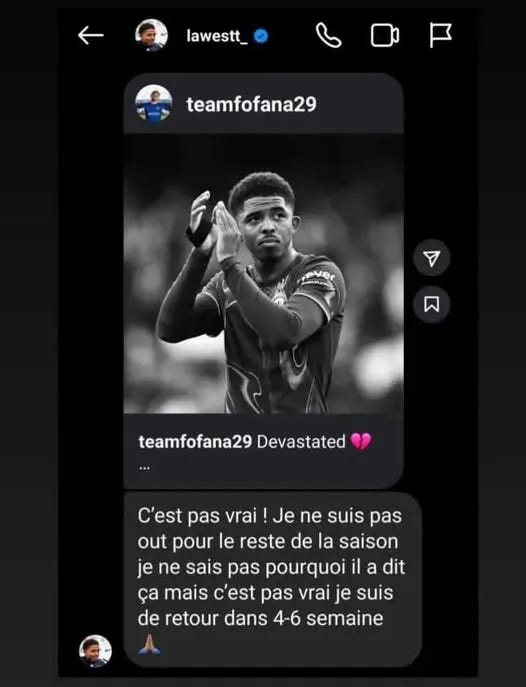
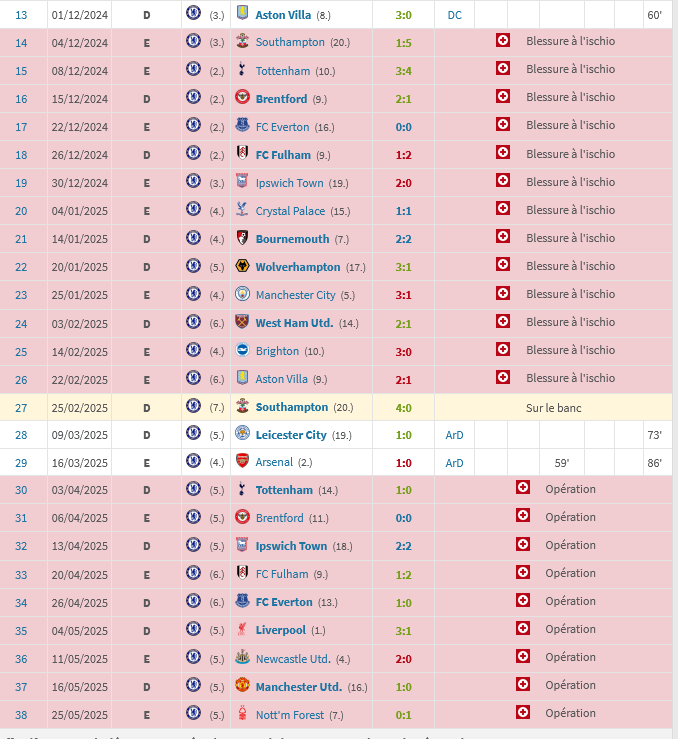
whilst the club was angrily gegenpressing Crystal Palace’s email box to not get Chalobah cup tied.
If Felix was pressing as well, defenders wouldn’t have to run back 20 times per game to defend long balls. The suicide shuttles.
A final point : replacing an injured player with a transfer, might be one of the worst things football tolerates as standard practice. Some clubs can indeed recall their best defenders they sent in the bomb squad.
From a financial standpoint, clubs can’t hide under the umbrella of “we’re forward planning”. No you’re not, you wait the last minute to call your mates and turn a pisstake suggestion as the only one that can be completed in 24h.
From a people management standpoint, you don’t stockpile “human capital” especially when that one player alone in the gym sees the replacement parading with the jersey all over the training ground.
An injured sportsman is a wounded animal, alone with their thoughts, tears and idea of the world, crumbling around him. The duty of care carries its weight. The number of extended backroom staff in top clubs makes it difficult for top players to be left to their own devices nowadays.
But football is also smaller scale professional clubs where there’s a first team S&C coach, maybe a couple of unpaid slaves interns and there’s the possibility to quit work at 12 to go home watch television.
Injured in October 2019 with a freak meniscus injury ; Aristide Mateta came back in July 2020 weeks ahead of schedule during a pandemic. One of the strongest athletes I’ve ever had the privilege of coming across.
End of season appraisal : I told him “I want you to be the team’s #9”
I saw him beaming and radiate the room.
Fast, likes to cut in from the left wing ? Fine, we’ll play diamond or 532 to release you early. No inverted fullbacks in the half spaces.
After 9 matchdays, his 4 goals 3 assists (2 penalies won) had him racking up joint Man Of the Match with Xavi Simons (PSG) for my U19 side.
He then made his international debut with DR Congo U23. Profiled here
Or add these extra hours mentoring the injured player as opposed to WhatsApp’ing a program to do on his own. I was fortunate to work with one of the best S&C coaches I’ve worked with, who made sure he’d deliver the sessions himself staying for hours with players.
There’s 15 million worth of professional players who cost 0 in there.
And countless he followed on their way to recovery
A lesson in creating value, not just from a financial stanpoint.
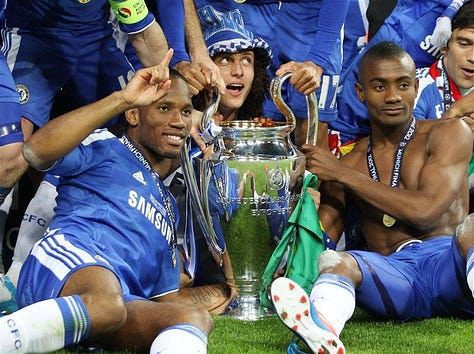
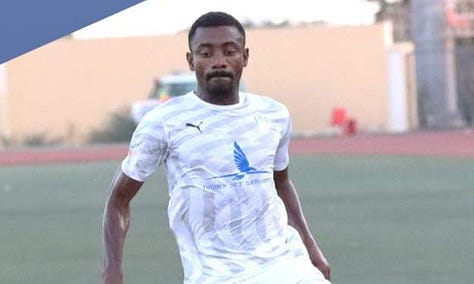
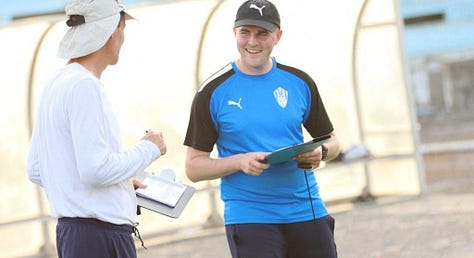
For Chelsea lore, guess who ended up coaching a nearly 40 year old Salomon Kalou in Djibouti? 😭
Values are only valid when nobody’s looking.
In many cases througout football, barely anyone is looking at or after an injured player when he’s grinding these stages of “return to play”.
So, Charly Musonda ;
1. Posterior Cruciate Ligament Injury ; what is it
2. Surgery or no surgery
3. The Stages of Rehabilitation
I found that video embedding lots of good snippets that align with every stage of recovery you can watch here, and are detailed later




